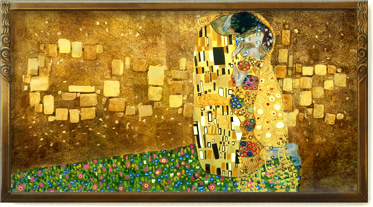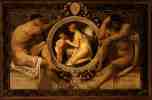Gustav Klint
Homenagem Google
Algumas imagens de Gustav Klimt e suas obras:
Imagem Adele Bloch-Bauer I-1907 Petróleo e ouro sobre tela, 138 x 138;
Galeria Austríaca, em Viena
Adele Bloch-Bauer apertando as mãos
(ela tinha um dedo deformado).
Vestida de ouro, cercada de ouro.
Uma imagem de muito ouro.
Uma imagem de muito ouro.
A obra,tesouro puríssimo!
o
Gustav Klimt nasceu em 14 Julho de 1862, em Baumgarten, perto de Viena, e
morreu em Fevereiro de 1918. O artista foi um dos fundadores do grupo
dos secessionistas, tendo sido um do seus presidentes.

Gustav Klimt
Klimt ficou obcecado com a dor gerada pelo retorno do recalcado,
Klimt ficou obcecado com a dor gerada pelo retorno do recalcado,
assim retratou em linguagem alegórica e simbólica a psique sofredora do homem moderno,
presa impotente do fluxo do destino. Era extremamente geometricista,
trazia em sua pintura a sensualidade, e seu tema principal era a mulher,
o erotismo
O Beijo ou Der Kuss no original em alemão (1907-08).
“Em O Beijo, a
roupa do homem é que é o tema da pintura,
e o elemento psicológico está
quase ausente...”
“...em Danaë, a estranha colocação do nu
nos faz ler a pintura como
um elemento plano.
O rosto da moça...tem aquele ar de concentração
erótica
em si mesma tão cara aos simbolistas...”
Retrato de Adele Bloch-Bauer I,
vendido em 2006 por 135 milhões de dólares.
Neue Galerie, Nova Iorque.
Friso Stoclet: O cumprimento
Imagem Judith I
1901 Österreichische Galerie, Vienna
1901 Österreichische Galerie, Vienna
Judith I, pintura sobre o relato bíblico
em que Judith corta a cabeça de Holofernes
The Maiden − 1913
O Chapéu de Plumas Negras
Gustav Klimt
A obra do pintor austríaco Gustav Klimt e ilustrador, b. 14 de julho de 1862, d. 6
de fevereiro de 1918, fundador da escola de pintura conhecido como o
Sezession Viena, incorpora as preocupações de alta chaveados eróticas,
psicológicas e estéticas de turn-of-the-century deslumbrante mundo de
Viena intelectual.
Amor imagem1895 (90 Kb); Museum der Stadt Wien, em VienaDetalhe de uma mulher bem vestida, fechando os olhos e abondonning-se ao seu primeiro beijo. Um homem cigano como olha para baixo em sua prestes a beijá-la.
Ele tem sido chamado de expoente de destaque da Art Nouveau. Klimt começou (1883) como um artista-decorador, em associação com seu irmão e Matsoh Franz. Em
1886-92, Klimt executado decorações murais das escadas no Burgtheater e
do Museu Kunsthistorisches de Viena; ecletismo estes Klimt confirmou e
ampliou sua gama de referências históricas. Klimt
foi um dos fundadores eo primeiro presidente da Secessão de Viena, um
grupo de arquitetos modernistas e artistas que organizaram sua sociedade
própria exposição e deu origem ao movimento da separação, ou a versão
vienense da Art Nouveau. Era também um contribuinte freqüente a Ver Sacrum, revista do grupo.
Entre
os projetos importantes decorativas realizadas por Klimt eram sua
célebre Beethoven Frieze (1902; Österreichische Galerie), um ciclo de
decorações de mosaico para Palais Josef Hofmann Stoclet, em Bruxelas
(1905-1909), ilustrações de livros e numerosos.
Image O Friso Beethoven1902 (120 Kb); Edifício da Secessão, VienaDetalhe da parede antes de o friso que representa a busca do homem de felicidade. Esta
seção mostra um homem nu e uma mulher rezando para o cavaleiro
(modelado em Gustav Mahler), que irá partir em busca da felicidade. Atrás do homem e da mulher é uma segunda mulher que olha sobre a contemplação. Acima da mulher dar outro cavaleiro do cavaleiro uma coroa de louros.
Image O Friso Beethoven1902 (110 Kb); Edifício da Secessão, VienaDetalhe da parede terço do friso que representa a busca do homem de felicidade. Esta seção mostra a mulher usada na sessão motivo repetição. Seu cabelo de roda eo ouro atrás dela tem um grão como a madeira.
As forças primitivas da sexualidade, regeneração, o amor ea morte formam os temas dominantes da obra de Klimt. Suas
pinturas de 'femmes fatales', como Judith I (1901; Österreichische
Galerie, Viena), personificam o lado escuro da atração sexual. O
beijo (1907-1908; Österreichische Galerie) comemora a atração dos
sexos, e espero que eu (1903; National Gallery, Ottawa) justapõe a
promessa de uma nova vida com a força de destruição de morte. O
sensualismo e originalidade da arte de Klimt levou a uma reação hostil
aos seus três murais do teto - Filosofia (1900), Medicina (1901), e de
Direito (1902) - para a Universidade de Viena.
Imagem Judith II(60 Kb)
Imagem Idylle1884 (60 Kb)
Imagem Dame mit Cabo1897-1898 (40 Kb)
Imagem Wasserschlangen eu1904-1907 (120 Kb)
Imagem Emilie Floge1902 (110 Kb); Historisches Museum der Stadt Wien, em VienaDetalhe de um retrato de Emilie Floge pé mão no quadril, em um vestido que ela desenhou.
Imagem Bildnis Margaret Stonborough-Wittgenstein1905 (30 Kb); Óleo sobre tela, 180 x 90cm; Baviera Colecção Estado de Pinturas, Neue Pinakothek, Munique
Imagem Bildnis Fritza Riedler1906 (60 Kb); Óleo sobre tela, 153 x 133 centímetros; Österreichische Galerie, Vienna
Imagem Danae1907 (90 Kb); Coleção particular, GrazDanae, aparentemente debaixo d'água, coxas elaborado. Ouro e prata fluxo seminal crescente entre as pernas. Muito erótico.A
legenda diz respeito a sua acasalamento com Zeus sob a forma de um
chuveiro de ouro, para conceber Perseu, que é descrito aqui. O
erotismo é altamente intencional: o cabelo vermelho, etc O pequeno
retângulo preto é a redução de Klimt de masculinidade de um símbolo
abstrato.

Imagem Adele Bloch-Bauer I-1907 Petróleo e ouro sobre tela, 138 x 138; Galeria Austríaca, em Viena

Mais detalhes O Beijo
Imagem Mada Primavesic. 1912 (220 Kb)

Imagem Die Jungfrau1913 (110 Kb); A Virgem; Narodni Galerie, PragaPintura muito colorida bonita de um grupo de mulheres bocejando, alongamento, dormindo. Parece que dez mulheres em uma cama com um monte de edredons coloridos. Brilhante.

Imagem namoradas1916-1917 (190 Kb)

Imagem Die Tänzerin1916-1918 (120 Kb)
Estilo
de Klimt inspirou-se em uma enorme gama de fontes: arte clássica,
greco-bizantino, egípcio, e Minoan; medieval, pintura e as xilogravuras
de Albrecht Dürer, fotografia e da arte simbolista de Max Klinger; eo
trabalho de ambos von Franz Preso e Fernand Khnopff. Ao sintetizar essas diversas fontes, a arte de Klimt alcançado tanto a individualidade e elegância extrema.
The work of the Austrian painter and illustrator
Gustav Klimt, b. July 14, 1862, d.
Feb. 6, 1918,
founder of the school of painting known as the Vienna Sezession,
embodies the high-keyed erotic, psychological, and aesthetic
preoccupations of turn-of-the-century Vienna's dazzling intellectual world.
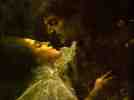 Love
Love
1895 (90 Kb); Museum der Stadt Wien, Vienna
Detail of a well-dressed woman closing her eyes and abondonning herself to her first kiss. A gypsy-like man looks down on her about to kiss her.
He has been called the preeminent exponent of ART NOUVEAU. Klimt began
(1883) as an artist-decorator in association with his brother and Franz
Matsoh. In 1886-92, Klimt executed mural decorations for staircases at the
Burgtheater and the Kunsthistorisches Museum in Vienna; these confirmed
Klimt's eclecticism and broadened his range of historical references. Klimt
was a cofounder and the first president of the Vienna Secession, a group of
modernist architects and artists who organized their own exhibition society
and gave rise to the SECESSION MOVEMENT, or the Viennese version of Art
Nouveau. He was also a frequent contributor to Ver Sacrum, the group's
journal.
Among the important decorative projects undertaken by Klimt were his
celebrated Beethoven frieze (1902; Osterreichische Galerie), a cycle of
mosaic decorations for Josef Hofmann's Palais Stoclet in Brussels (1905-09),
and numerous book illustrations.
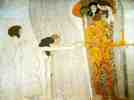 The Beethoven Frieze
The Beethoven Frieze
1902 (120 Kb); Secession Building, Vienna
Detail from the first wall of the frieze depicting man's search of happiness. This section shows a naked man and woman praying for the knight (modelled on Gustav Mahler) who will set out in search of happiness. Behind the man and woman is a second woman who gazes on in contemplation. Above the knight other woman give the knight a laurel crown.
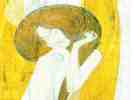 The Beethoven Frieze
The Beethoven Frieze
1902 (110 Kb); Secession Building, Vienna
Detail from the third wall of the frieze depicting man's search of happiness. This section shows the woman used in the repeating motif sitting. Her swirling hair and the gold behind her have a grain like wood.
The primal forces of sexuality, regeneration, love, and death form the
dominant themes of Klimt's work. His paintings of femmes fatales, such as
Judith I
(1901; Osterreichische Galerie, Vienna), personify the dark side of
sexual attraction.
The Kiss
(1907-08; Osterreichische Galerie) celebrates
the attraction of the sexes; and
Hope I (1903; National Gallery, Ottawa)
juxtaposes the promise of new life with the destroying force of death.
The sensualism and originality of Klimt's art led to a hostile reaction to
his three ceiling murals--Philosophy (1900), Medicine (1901), and
Jurisprudence (1902)--for the University of Vienna.
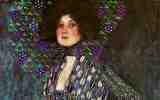 Emilie Floge
Emilie Floge
1902 (110 Kb); Historisches Museum der Stadt Wien, Vienna
Detail from a portrait of Emilie Floge standing hand on hip, in a dress that she designed.
 Bildnis Margaret Stonborough-Wittgenstein
Bildnis Margaret Stonborough-Wittgenstein
1905 (30 Kb); Oil on canvas, 180 x 90cm; Bavarian State Collection of Paintings, Neue Pinakothek, Munich
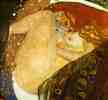 Danae
Danae
1907 (90 Kb); Private collection, Graz
Danae, seemingly underwater, thighs drawn up. Gold and silver seminal flow rising between her legs. Very erotic.
The legend concerns her mating with Zeus in the form of a gold shower, to conceive Perseus, which is depicted here. The eroticism is highly intentional: the red hair, etc. The small black rectangle is Klimt's reduction of maleness to an abstract symbol.
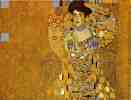 Adele Bloch-Bauer I
Adele Bloch-Bauer I
1907 (140 Kb); Oil and gold on canvas, 138 x 138; Austrian Gallery, Vienna
Adele Bloch-Bauer clasping her hands (she had a deformed finger). Dressed in gold, surrounded by gold. A very gold picture.
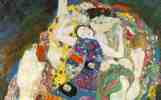 Die Jungfrau
Die Jungfrau
1913 (110 Kb); The Virgin; Narodni Galerie, Prague
Beautiful very colourful painting of a group of women yawning, stretching, sleeping. It looks like ten women in one bed with loads of colourful duvets. Brilliant.
Klimt's style drew upon an enormous range of sources: classical Greek,
Byzantine, Egyptian, and Minoan art; late-medieval painting and the woodcuts
of
Albrecht Dürer;
photography and the symbolist art of Max Klinger; and the
work of both Franz von Stuck and Fernand Khnopff. In synthesizing these
diverse sources, Klimt's art achieved both individuality and extreme
elegance.
(Continuar ordenando imagens e textos)

Gustav Klimt

Pablo Picasso

Li
Fonte:
http://globosite.in/gustav-klimt-imagens/
WebMuseumParis-http://www.ibiblio.org/wm/paint/auth/klimt/
http://archeblog.blogspot.com.br/2012/07/geometria-e-sensualidade-gustav-klimt.html
http://globosite.in/gustav-klimt-imagens/
WebMuseumParis-http://www.ibiblio.org/wm/paint/auth/klimt/
http://archeblog.blogspot.com.br/2012/07/geometria-e-sensualidade-gustav-klimt.html
Sejam felizes todos os seres. Vivam em paz todos os seres.
Sejam abençoados todos os seres.
Sejam abençoados todos os seres.
